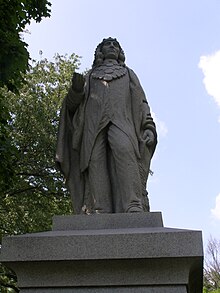Chief Menominee | |
|---|---|
 Menominee Statue, Plymouth, Indiana | |
| Born | c. 1791 |
| Died | April 15, 1841 |
| Nationality | Pottawatomie |
| Occupation | Pottawatomie chieftain |
| Known for | Pottawatomie chieftain during the Trail of Death |
Menominee (c. 1791 – April 15, 1841) was a Potawatomi chief and religious leader whose village on reservation lands at Twin Lakes, 5 miles (8.0 km) southwest of Plymouth in present-day Marshall County, Indiana, became the gathering place for the Potawatomi who refused to remove from their Indiana reservation lands in 1838. Their primary settlements were at present day Myers Lake and Cook Lake. Although Menominee's name and mark appear on several land cession treaties, including the Treaty of St. Mary's (1818), the Treaty of Mississinewas (1826), the Treaty of Tippecanoe (1832), and a treaty signed on December 16, 1834, he and other Potawatomi refused to take part in subsequent land cession negotiations, including the Treaty of Yellow River (1836), that directly led to the forced removal of Menominee's band from Indiana in 1838.
Despite his efforts to resist removal, Menominee was among the 859 Potawatomi who were forcibly removed from Twin Lakes, Indiana, to Indian reservation lands near present-day Osawatomie, Kansas, on what became known as the Potawatomi Trail of Death. The journey from September 4, 1838, to November 4, 1838, covered about 660 miles (1,060 km) over 61 days; 42 died (28 of them were children) along the route. It was the single largest Indian removal from Indiana. Menominee survived the march to Kansas, but died less than three years later, and is buried at St. Mary's Mission, Kansas. In 1909 the State of Indiana erected a statue of him near the headwaters of the Yellow River, 3 miles (4.8 km) southwest of the present-day town of Plymouth, Indiana, near the site of his former village at Twin Lakes. It is the first monument to a Native American erected under a state or federal legislative enactment.